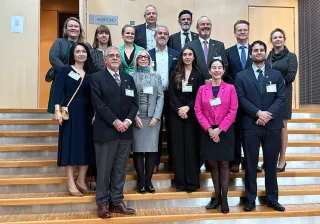78 % of Finland is covered in forests, but the materials for packaging, clothes and electronics are still drilled from the ground as oil. VTT challenged the idea that print media was the only commercialisable, high added value product that could be sourced from the forest.
VTT has developed both methods for converting packaging waste into energy and new materials through gasification, and various food and product packaging applications that are recyclable and partially produced from bio-waste mass. We have also developed different solutions for using waste cellulose for textile fibres.
With cellulose we can
- Minimise food spoilage – with new packaging solutions and materials
- Have a healthy and safe home – with composites entirely built from cellulose (surface finishes and textiles for hospitals, for example)
- Improve safety and the quality of life – with wearable materials (wearable assistive device for the visually impaired, for example)
- Free our oceans and soil of plastic trash and microplastics – with biodegradable (packaging) materials based on a fibrous web.
Each year, humankind generates 300 million tonnes of plastic waste, which cannot be efficiently reused by the industry. However, applications produced from cellulose are fully recyclable, they have a significant added value and they can be partially produced from industrial cellulose waste, such as sugar beet peelings.
With VTT's innovations, it's possible to double the value of cellulose products and create a 33 % growth in forest industry exports by the year 2040. For example, the value of cellulose pulp is from 600 to 900 € for a thousand kilos, whereas the VTT developed cellulose-based light cable is priced from 13 000 to 20 000 € per thousand kilos.
In the 2020s, the use of wood will increase in three fields in particular: wood construction, wood-based textiles and replacement of plastics. In the 2030s, cellulose will be found in the strangest of places. Cellulose will be found in clothes, cars, household appliances, intelligent energy systems and, perhaps, even inside humans.
The success of circular economy requires extensively networked ecosystems of universities, research institutes and companies. Even the major industrial actors no longer work alone. The creation of impactful solutions requires points of contacts with the everyday lives of people and constant interaction with decision-makers in the fields of business, research and public administration.
VTT brings together huge ecosystems and development projects, with which we create comprehensive solutions for bio economy and material research – emphasis on textile recycling, waste problem solution and reuse of different products.
Companies born from VTT innovations:
Paptic
Among the ten most interesting start-ups. / Talouselämä 2017
VTT’s spinoff manufactures packaging and carrying bags for consumer brands from cellulose. In 2018, a factory will be established for the production, promising 50 jobs.
Infinited Fibre Company
EUR 1.5 million in net sales after two years of operation
Manufactures a recyclable fabric from textile waste using technology developed by VTT. The properties of the fabric are like a mixture of cotton and viscose. In 2019, the product will be able to compete in price with cotton textile products.
Spinnova
A method that can save 99 % water
Spinnova is commercialising a cellulose-based textile fibre technology, originally developed at VTT, where the fibre is directly produced from pulp from a pulp mill. No harmful chemicals are used in the process, which makes this fibre unique. Compared to the production of cotton, the method can save 99 %. This heralds a seismic breakthrough, as production progresses to industrial scale, probably in 2018.







